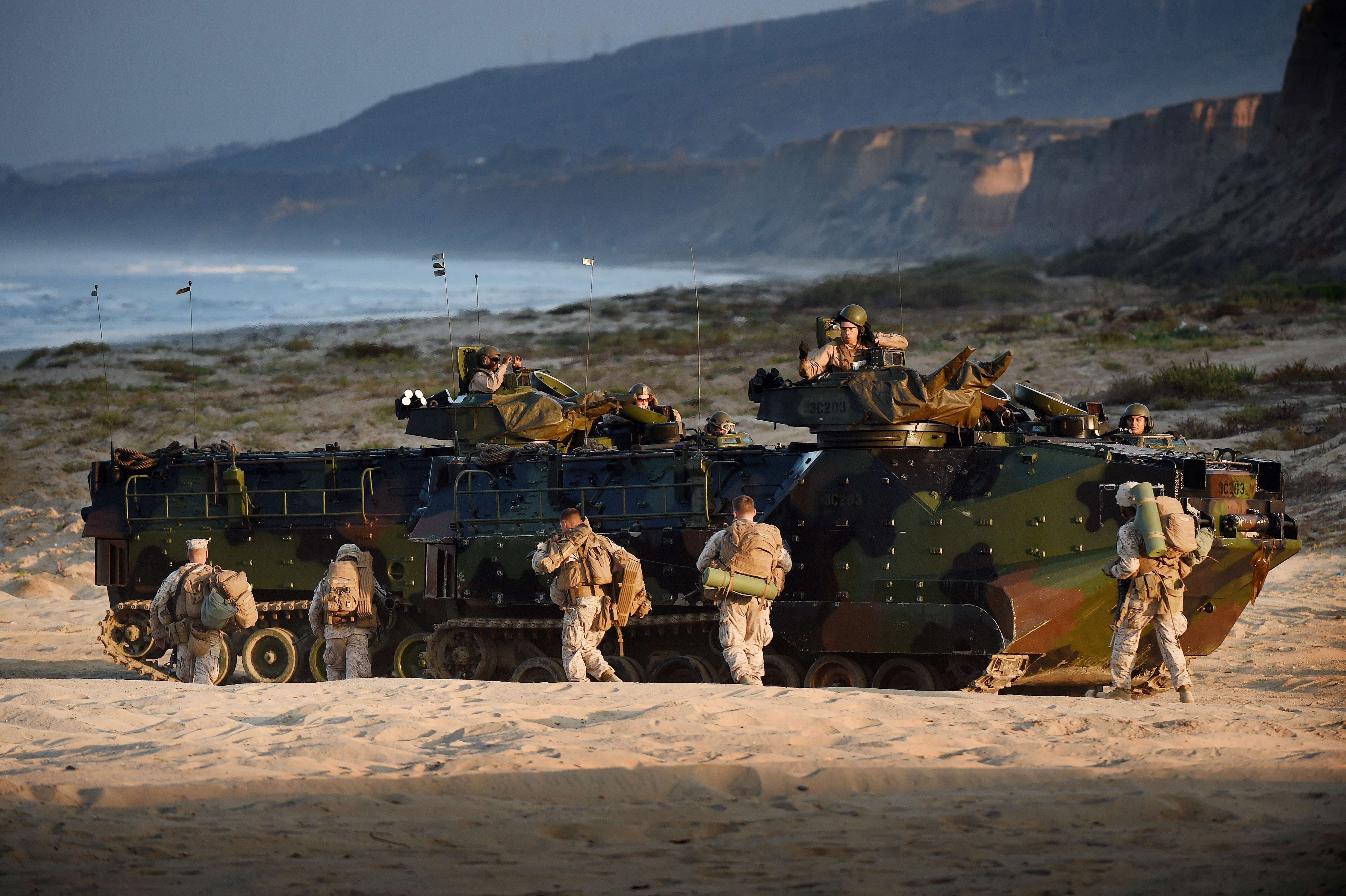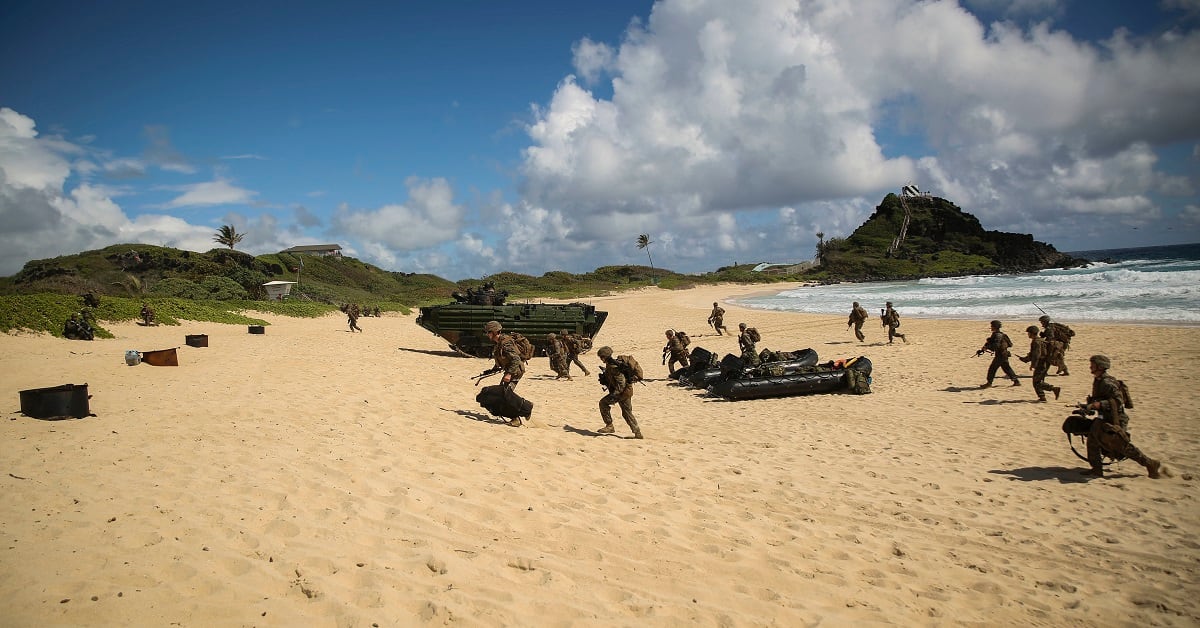The Navy and Marine Corps are only “marginally” capable of meeting America’s national security needs, according to a new scorecard from The Heritage Foundation.
The the conservative think tank’s 2021 Index of U.S. Military Strength had more than 20 authors take a look at the global operating environment and the mission of each branch of the U.S. military, it said.
With an eye on near-peer competitors like China and Russia, as well as regional threats like Iran and North Korea, the organization graded each branch of the U.S. military based on its ability to complete its mission. The report graded all the military branches based on capacity, capability and readiness on a scale ranging from “very weak” to “very strong.”
The Marine Corps received a rank of “marginal,” the middle score on the table, in all three categories and a marginal overall score.
While the Navy received a “marginal” score in capability and readiness, while its capacity was marked as “weak.” The Navy’s overall score was marked as “marginal,” but the report notes the service is trending in the “weak” direction.
RELATED

The report also looked into the Army, Air Force and the nation’s nuclear capability, giving all three a “marginal” overall rating.
The Army got top marks of “very high” on the readiness score, but its capacity was graded as “weak” and its capability was marked as “marginal.”
The Air Force was ranked as marginal in all three individual categories.
“These characterizations should not be construed as reflecting either the competence of individual servicemembers or the professionalism of the services or Joint Force as a whole,” the report said.
“Rather, they are assessments of the institutional, programmatic, and material health or viability of America’s hard military power,” the report added.
‘Marginal’ Marine Corps
While the Marine Corps received a “marginal” grade, it generally is trending in the right direction, Dakota Wood, a retired Marine lieutenant colonel and a current senior research fellow at The Heritage Foundation and co-author of the report, told Marine Corps Times.
“Size-wise it’s still too small, equipment-wise it still has old equipment, but it’s a very ready force,” Wood said.
“What the Marine Corps is doing is they’re trying to make sure that they are relevant in the future,” he added.
The Marine Corps took a hit on its capacity score because of its aging fleet of vehicles, including the Vietnam-era amphibious assault vehicle and the nearly 40-year-old CH-53E Super Stallion heavy lift helicopter.
But the Corps seems to be well on its way of replacing those vehicles with newer more powerful versions. The first Amphibious Combat Vehicle hit the fleet in November and the CH-53K recently has overcome its initial technical problems and is expected to reach initial operational capability by 2021, according to the Marine Corps.
The biggest hurdle for the Marine Corps to overcome in future fights is its size, according to the report.
By analyzing every fight the Marine Corps has been involved with since the Korean War, Wood estimated the Corps would need 15 infantry battalions, along with the supporting force, to be effective.
In past years, the Heritage report based the Corps’ grade off its ability to fight in two such conflicts and estimated that it would require at least 36 infantry battalions to meet that need while holding some forces in reserve.
Under that assessment the Marine Corps with “only” 24 infantry battalions would have received an overall grade of “weak.”
In 2020 Wood accepted the Marine Corps’ insistence that it is a one-war force with an added crisis response mission. Under the new evaluation the estimated requirement was lowered by Wood to 30 infantry battalions and the Corps score was moved up to “marginal.”
However, the Marine Corps is planning for more downsizing.
In February, the Marine Corps budget request proposed a cut of 2,257 enlisted Marines alongside an increase of 158 officers.
At the time, Berger promised even more personnel cuts as the Corps attempts to reinvest in more modern tech.
In November the Senate Appropriations Committee proposed an acceleration to those cuts, reducing the Marine Corps by 6,000 Marines in its draft of the 2021 defense funding bill.
If the Corps goes through with the planned personnel cuts, it would receive an overall “weak” grade, according to the report.
RELATED

But it is not all bad news for the Marine Corps.
The force is undergoing a massive transition from one that has spent nearly two decades fighting a counterinsurgency war in the Middle East to one specifically designed to counter China in the littoral waters of the South China Sea.
As part of the transition, Marine Corps commandant Gen. David Berger envisions the Corps as slightly smaller, significantly lighter and much more maneuverable.
Berger wants the Marine Corps to be able to operate with small groups of Marines spread out over vast distances and capable of delivering a big blow to any enemy.
“There are revolutionary leaders of organizations and there are steward leaders of organizations,” Scott Cooper, a Marine veteran and former congressional candidate, told Marine Corps Times while describing Berger’s vision for the future Corps. “Berger is a revolutionary leader.”
Wood said he fully supports the commandant’s vision for the future of the Corps, but without data from the Corps’ wargaming and force design just now entering its real-world experimentation phase he was unable to factor the plans into the 2020 score.
The report also is meant as a measure of where the Corps is in case war broke out right now, he said. Though Berger has gotten his plan rolling, it is still years away from being fully implemented.
“What we’re trying to convey to the American public and to representatives and staffers on Capitol Hill, is this is the military you have today,” Wood said.
“If we had to go to war tomorrow or next month or next year, you can’t magically make the future Marine Corps, the Marine Corps that you’re using today,” he added.
The Corps’ anchor
The Corps is trending in the right direction, experts said. But the Navy, trending in the wrong direction, has the potential to pull the Marine Corps down with it.
A fleet roughly 100 ships too small, mixed with shipyards “overwhelmed by the amount of repair work needed,” has put the Navy heading straight toward a “weak” rating, according to the report.
The Heritage Foundation report recommends that the Navy have 400 “battle force ships.” The Navy is building toward a fleet of 355 ships, as required by law, but has stumbled several times on its way to a growing fleet.
The Navy currently less than 300 ships.
The categories, “other than capacity … which is still weak, don’t tend upwards at all,” said Brent Sadler, a Navy veteran, current senior fellow at The Heritage Foundation and a co-author on the report.
They are “beginning to trend more aggressively downward unless the build-up to 355 ships actually accelerates,” Sadler said.
These trends are particularly evident in the Western Pacific, where roughly 60 ship are deployed at any given time and could potentially be forced to faceoff against China’s 350 ship force on a moment’s notice.
Though the winds are blowing in the wrong direction for the Navy, it is not all bad news, according to Wood.
“There is a potential for the Navy, acting as the anchor, the drag, that keeps the Marine Corps from realizing what it needs to be,” Wood said.
“But it is also possible the success the Marine Corps has in developing and proving these new concepts pulls the Navy forward.”
The Heritage report takes a deep dive into the current state of the military and the threats it must deal with. But the recommendations on force size, structure and equipment come without budget limitations that will surely face the next president and Congress.
“The Heritage Foundation is not limited to fiscal realities, they are simply saying this is what we need,” Cooper said.
While Berger already has planned to transform the Marine Corps in future with a shrinking military budget, the spiking U.S. deficit amid the ongoing COVID-19 pandemic may challenge even his frugality.
“We have a pandemic, we have budget deficits and we need to probably change our discretionary spending … whatever party is in the majority in either House of Congress,” Cooper said.





